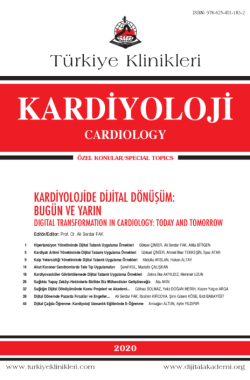We Will Develop Artificial Intelligence in Health with Physicians
Ata AKINa
aAcıbadem Üniversitesi Mühendislik Fakültesi, Tıp Mühendisliği Bölümü, İstanbul, TÜRKİYE
Akın A. Sağlıkta yapay zekâyı hekimlerle birlikte biz mühendisler geliştireceğiz. Fak AS, editör. Kardiyolojide Dijital Dönüşüm: Bugün ve Yarın. 1. Baskı. Ankara: Türkiye Klinikleri; 2020. p.26-31.
ABSTRACT
Clinical innovation has always been accomplished by engineers working with creativeminded health professionals. In this work, in a process where innovation is extremely accelerated, I will discuss about how to collaborate with engineers and healthcare professionals in order to maximize healthcare performance, why we need this cooperation specifically in the field of digital health, and how we can achieve this.
Keywords: Articial intelligence; clinical decision-making; clinical decision rules
Kaynak Göster
Referanslar
- Gunal MM, Pidd M. Discrete event simulation for perfor-mance modelling in health care: a review of the literature. journal of Simulation. 2010;4(1):42-51. [Crossref]
- Zelman WN, Pink gH, Matthias CB. Use of the balanced scorecard in health care. journal of health care nance. 2003;29(4):1-16.
- Amoore j, Hegarty F, McCarthy j, Scott R, Blackett P. The role of clinical engineers in supporting patients. In Clinical Engineering. Elsevier; 2020. p.3-16. [Crossref]
- Olsen KD, Dacy MD. Mayo clinic 150 years of serving humanity through hope and healing. 2014;89:8-15. [Crossref] [PubMed]
- Blumenthal-Barby jS, Krieger H. Cognitive biases and heuristics in medical decision making: a critical review using a systematic search strategy. Medical decision making : an international journal of the Society for Medical Decision Making. 2015;35:539-57. [Crossref] [PubMed]
- Djulbegovic B, Hozo I, Beckstead j, Tsalatsanis A, Pauker Sg. Dual processing model of medical decision-making. BMC medical informatics and decision making, 12:94, September 2012. [Crossref] [PubMed] [PMC]
- Marcum jA. The role of emotions in clinical reasoning and decision making. The journal of medicine and philosophy. 2013;38:501-19. [Crossref] [PubMed]
- Trimble M, Hamilton P. The thinking doctor: clinical decision making in contemporary medicine. Clinical medicine (london, England). 2016;16:343-6. [Crossref] [PubMed] [PMC]
- Lamond D, Thompson C. Intuition and analysis in decision making and choice. journal of nursing scholarship: an o cial publication of Sigma Theta Tau International Honor Society of Nursing. 2000;32:411-4. [Crossref] [PubMed]
- Banning M. A review of clinical decision making: models and current research. journal of clinical nursing. 2008;17:187-95. [Crossref] [PubMed]
- Croskerry P, Norman g. Overcon dence in clinical decision making. The American journal of medicine. 2008;121:S24-9. [Crossref] [PubMed]
- Engebretsen E, Heggen K, Wieringa S, green-halgh T. Uncertainty and objectivity in clinical decision making: a clinical case in emergency medicine. Medicine, health care, and philosophy. 2016;19:595-603. [Crossref] [PubMed] [PMC]
- Hall KH. Reviewing intuitive decision-making and uncertainty: the implications for medical education. Medical education. 2002;36:216-24. [Crossref] [PubMed]
- Muir N. Clinical decision-making: theory and practice. Nursing standard (Royal College of Nursing (great Britain): 1987). 2004;18:47-52; quiz 54-5. [Crossref] [PubMed]
- Nalliah RP. Clinical decision making - choosing between intuition, experi-ence and scienti c evidence. British dental journal. 2016;221:752-4. [Crossref] [PubMed]
- Pearson H. Science and intuition: do both have a place in clinical decision making? British journal of nursing (Mark Allen Publishing). 2013;22:212-5. [Crossref] [PubMed]
- Ahmed Z, Mohamed K, Zeeshan S, Dong XQ. Articial intelligence with multi-functional machine learning platform development for better healthcare and precision medicine. Database (Oxford). 2020. [Crossref] [PubMed] [PMC]
- Braithwaite j, glasziou P, Westbrook j. The three numbers you need to know about healthcare: the 60-30-10 challenge. BMC Med. 2020;18(1):102. [Crossref] [PubMed] [PMC]
- Ghosh A, Kandasamy D. Interpretable articial intelligence: Why and when. AjR Am j Roentgenol. 2020;214(5):1137-8. [Crossref] [PubMed]
- Hatherley jj. limits of trust in medical ai. j Med Ethics. 2020. 21. Reddy S, Fox j, Purohit MP. Articial intelligence-enabled healthcare delivery. j R Soc Med. 2019;112(1):22-8. [Crossref] [PubMed] [PMC]
- Samuel g, Derrick g. De ning ethical standards for the application of digital tools to population health research. Bull World Health Organ. 2020;98(4):239-44. [Crossref] [PubMed] [PMC]
- Triberti S, Durosini I, Pravettoni g. A "third wheel" ect in health decision making involving arti cial entities: A psychological perspective. Front Public Health. 2020;8:117. [Crossref] [PubMed] [PMC]
- Buyukgoze S, Dereli E. Dijital saglık uygulamalarında yapay zeka. VI. Uluslararas Bilimsel ve Mesleki Calısmalar Kongresi-Fen ve Saglık; 2019. p.7-10.
- gezer M, Bulut M, Dilmen N, Esmer g, Erol C, Sener l. Saglik Bilimlerinde Yapay Zeka. Celebi Kitabevi; 2019. p.12.
- Elgiz Yılmaz Altuntas. Saglık Hizmetleri Uygulamalarında Dijital Donusum. Egitim Yayınevi, 2019.
- Florence Nightingale. Notes on nursing: what it is, and what it is not. lippincott, Philadelphia, commemorative ed edition, 1992.
- Omachonu VK, Einspruch Ng. Innovation in healthcare delivery systems: a conceptual framework. The Innovation journal: The Public Sector Innovation journal. 2010;15(1):1-20. 29 Nebeker F. golden accomplishments in biomedical engineering. IEEE Engineering in Medicine and Biology Magazine. 2002;21(3):17-47. [Crossref] [PubMed]
- Grigoroudis E, Orfanoudaki E, Zopounidis C. Strategic performance measurement in a healthcare organisation: A multiple criteria approach based on balanced scorecard. Omega. 2012;40(1):104-19. [Crossref]
- Zambuto RP. Clinical engineers in the 21st century. IEEE Engineering in medicine and biology magazine. 2004;23(3):37-41. [Crossref] [PubMed]
- Wall j, Wynne E, Krummel T. Biodesign process and culture to enable pediatric medical technology innovation. Seminars in pediatric surgery. 2015;24:102-6. [Crossref] [PubMed]
- Wall j, Hellman E, Denend l, Rait D, Venook R, lucian l, et al. The impact of postgraduate health technology innovation training: Outcomes of the stanford biodesign fellowship. Annals of biomedical engineering. 2016. [Crossref] [PubMed] [PMC]
- Wynne EK, Krummel TM. Innovation within a univer-sity setting. Surgery. 2016;160:1427- 31. [Crossref] [PubMed]
- Yock Pg, Brinton Tj, Zenios SA. Teaching biomedical technology innovation as a discipline. Sci Transl Med. 2011;3(92):92. [Crossref] [PubMed]
- Yock Pg, Zenios S, Makower j, Brinton Tj, Kumar UN, jay Watkins FT, et al. Biodesign. Cambridge University Press; 2015. [Crossref]

